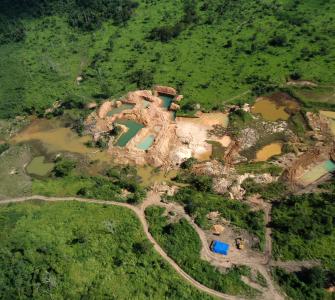Illegal artisanal and small-scale gold mining (ASGM) poses a significant threat to ecosystems around the world, and perhaps most urgently, to the Amazon biomes. The threat is not only due to the deforestation and degradation caused by the industry but from the use of mercury to amalgamate gold, which then seeps into both surface and subterranean waterways, poisoning the water and entering the local food chain via fish.
ASGM is the largest source of anthropogenic mercury emissions in the world, releasing the toxic substance into the atmosphere, soil, and surrounding bodies of water. Illegal gold mining has grown in the last decade, fostered by a sustained rise in international gold prices. In countries such as Brazil, Colombia, Bolivia, and Peru, alluvial and land-based mining pollutes rivers and streams. National statistics reveal alarming rates of mercury poisoning among indigenous groups and local populations, a problem that is not fully assessed, given that many of the contaminated fish species are also consumed by regions outside the Amazon biome.
Conservation Strategy Fund (CSF), in partnership with La Fundación para la Conservación y el Desarrollo Sostenible (FCDS), worked to bolster the capacity of institutions in Brazil, Colombia, Peru to assess the socioeconomic and environmental impacts of gold mining by adapting economic tools such as the Mining Impacts Calculator to the Peruvian and Colombian contexts. This calculator was originally designed in Brazil as part of our partnership with the Brazilian Federal Public Prosecutor's Office (MPF) and was launched in 2021.
The Calculator allows users to estimate monetarily the average socio-environmental costs of illegal gold mining activities with an easy-to-use, evidence-based tool for reliable economic information. The calculator supports better decision-making, raises awareness of the impacts associated with ASGM, and informs the enforcement of regulations against illegal activities in the sector to better protect the Amazon biome.
In September and November 2022, we held national workshops in Leticia, Colombia and Lima, Peru respectively to disseminate the updated methodology. In addition, we presented the application of the calculator in two case studies in zones of the triple border between Peru, Colombia, and Brazil. The first area is located in the territory of the Puré River, on the border between the department of Amazonas in Colombia and the municipality of Japurá in Brazil; the second area covers the department of Loreto in Peru, the department of Amazonas in Colombia, and the municipalities of Santo Antônio do Içá and Tabatin in Brazil. The study is available here (in Spanish).
Public officials from the environment, mining, health, and defense sector, representatives of civil society organizations, and indigenous organizations attended these workshops, to validate the tool. These dialogues improved the functionality of the calculator and understanding of its uses, and led to CSF presenting an updated version of the tool launched in March 2023.
We held meetings with officials from the Ministry of the Environment and the Attorney General's Office of the Republic of Peru and with the Colombian Attorney General's Office to promote the implementation of the calculator. Finally, CSF and FCDS organized an international event to share the lessons learned in the use and adaptation of the web tool, called "Regional Exchange Meeting: Impact Calculator of Illegal Gold Mining in Brazil, Peru, and Colombia", where the new version of the gold Mining Impacts Calculator was presented. More information on this can be found in this press release (in Spanish).
In Peru, officials from the regional governments of Loreto and Madre de Dios, representatives of civil society organizations, academia, and decentralized agencies learned the main valuation methods to evaluate the effects of mining and the use of mercury in a one-and-a-half-day training course.
Assessing the impacts of ASGM and calculating a monetary value for these impacts allows for strengthened policies, raises visibility of the issues for the general public and communities affected by mining, and encourages investments in the prevention and the remediation of harmful impacts on the environment and local communities.
Read the adapted methodology (in Spanish) for each country here: Peru and Colombia.
This project was possible with the support of the Amazon Sustainable Landscapes Program (ASL), led by the World Bank and funded by the Global Environment Facility (GEF), and implemented in partnership with La Fundación para la Conservación y el Desarrollo Sostenible (FCDS). USAID's Prevent Project provided additional support for the socialization of the tool and its methodology, complementing efforts to increase its reach and influence in Peru.
Photo: Aerial view of gold mining area in Amazon forest region, Para state, Brazil
Photo Credit: Shutterstock, Tarcisio Schnaider

